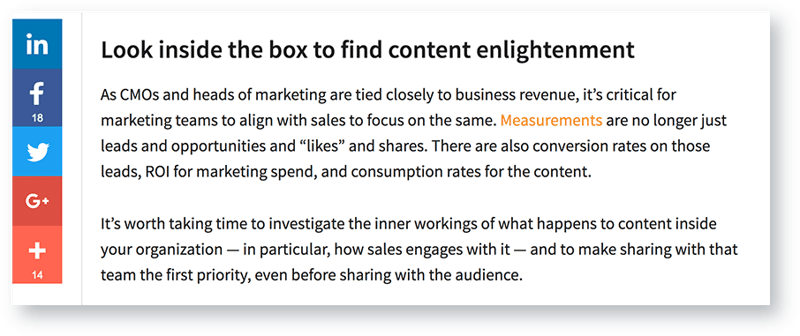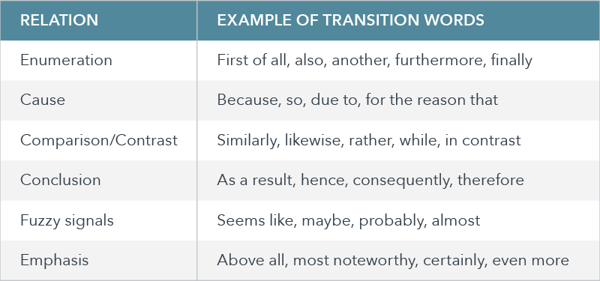According to research done by HubSpot, 55% of marketers say that blogging is their top inbound priority and 43% of people admit to skimming blog posts. For most of us, blogging is simply a way for us to put our content out for the world to see. Keeping this in mind, you’ll notice there is a ton of competition and not a lot of people that are thoroughly reading blog posts. So, how do you write content that is able to be skimmed, yet still effective?
This checklist is designed to help guide the writer through best practices to review and optimize content.
>> Don't have time to read this whole article? Grab the quick and dirty checklist for writing better web content.
1. Use short paragraphs.
Key question: Are paragraphs shortened or broken up to a few sentences each?
Web copy is meant to be skimmed, and even if the article or content piece is long, the reader cannot effectively manage large blocks of copy – especially depending on whether they’re ready on mobile vs desktop.
QuickSprout and the NeilPatel.com team do this very well:

2. Use subheadings effectively.
Key question: Are subheads used to guide the reader through the content?
Think of subheadings as road signs throughout your article. They help the draw the reader into the content and keep them moving toward a conclusion. Subheadings also make it easy to skim the content and sell the content to the reader, section by section. Be specific and persuasive rather than generic.
Content Marketing Institute articles are all subhead friendly. Here's a example:

3. Bullet points and lists are your friend.
Key question: Have you used bullet points or lists to break up walls of text?
Use short paragraphs, subheadings, bulleted lists, and plenty of line breaks to keep the words easy to scan. That way when someone does want to read every word, it’s easier on their eyes.
4. Watch for wordiness.
Key question: Have you checked for and eliminated wordiness?
Read your work, and see if there are any words you can get rid of without affecting the material. Ensure you haven’t belabored a point too much or talked about something a few times in the same way in the article. This tightens up your writing and improves quality. Think of it as goldilocks writing - not too much, not too little....just the right amount to be effective!
5. Guide the reader to key points.
Key question: Did you strategically utilize bold, italics and a stylized sentences to emphasize key points for the reader to consider?
Bold and italics can make a reader stop and pause. It also allows the author to place emphasis on points that are worth more weight in the article.
6. Demonstrate external credibility.
Key question: Are there links out to a few other resources or websites in the article?
Outbound links help establish authority and have been shown to be a positive practice for SEO. Plus, when promoting the article on social media, you can give a nod or mention to the company or individual you linked to.
The Backlinko blog is great about pointing readers to additional information or sources of credibility like this:

In that example, the pogosticking article the author is referring to is a post on a Moz.com, popular SEO software blog.
7. Encourage the reader to pass on the information.
Key question: Did you give the readers a chance to share the article, or tweet an image or sentence from the article?
Reading a post is good. Getting someone to read it and share it is better. In order to do this, you’ll need to build in ways to encourage the reader to share, whether it’s a “shareable tweet” or an invitation to add comments or interact on social media.
To see this in action, we've included several graphics in this article that say "tweet this"! If you're interested in doing this on your own blog, check out this plugin for yourself at https://clicktotweet.com/.
8. Use transition words.
Key question: Does the article lead the reader through the copy using “transition words”?
Using transition words, such as “because”, and “seems like” and “lastly” makes your text much more readable. Why? Because these words give direction to the person reading your copy! (see what we did there?)

Source: yoast.com/transition-words-and-seo/
Using transition words helps solidify the relationship between two sentences or sections of text. For a deeper understanding of what types of words this may include, check out this article from Yoast.
9. Don't forget the basics from English class.
Key question: Does the article follow proper grammar, spelling, and punctuation? (This includes removing double spaces)
Double spaces are reserved for the era of the typewriter. Modern web writing should not have double spaces after periods. Grammar, spelling, and punctuation can be reviewed using tools in word processing systems and blogging tools, but a human review is still best to catch remaining edits.
Note: Proper grammar for conversational writing varies, so the rules here are a bit more loose. It’s ok to start a sentence with “and” or have fragments to prove a point or place emphasis on something.
10. Vary your words.
Key question: Did you avoid using the same syntax over and over?
No one likes to read the same sentence structure repeatedly. It makes the reader bored and uninterested. Be sure to switch up the way you frame your sentences throughout your writing.
An example of a paragraph that needs more variety may look something like this:
"HubSpot is a powerful marketing tool. HubSpot has a number of subscription levels available, ranging from starter to enterprise. HubSpot’s most known for creating the inbound marketing movement and helping marketers drive leads through content marketing."
The repetition of the word “HubSpot” is repetitive and distracts from the power of the message. To avoid this type of repetition, try adjusting the placement of the word with a pronoun, or using more prepositional phrases so that the subject (the word “HubSpot”) does not open each sentence.
"HubSpot is a powerful tool for marketers in a variety of industries. Because budget and marketing needs vary, HubSpot offers a number of subscription levels ranging from starter to enterprise. As creators of the inbound marketing movement, HubSpot helps business of all sizes drive traffic and generate leads through content marketing."
11. Watch for run-on sentences.
Key question: Did you eliminate run-on sentences?
Long-winded sentences make it difficult for the reader to stay engaged. In some cases, it also signals to search engines that your copy is challenging and may be abandoned (bounced). Break down long sentences into shorter sentences and vary syntax and transition words to keep the copy flowing.
12. Incorporate visuals throughout your writing.
Key question: Are images or graphics utilized in the article to illustrate key points and provide variety between content types?
With the variety of content mediums available today, text is only one way to share a message. The best content on the web utilizes a combination of written, visual, and multimedia type of formats to engage a variety of readers and blend the approach of “show and tell”.
Now it’s your turn.
After reading this checklist, you probably have a good idea of what you are doing well, and what you need to improve on. Writing effective web content is very important in 2018, especially if you are looking to improve on your SEO efforts. Use these tips to optimize your content, keep readers engaged, and establish your blog as a credible resource.
Comments or questions? We'd love to hear how you're putting these tips into practice with your own content marketing!



